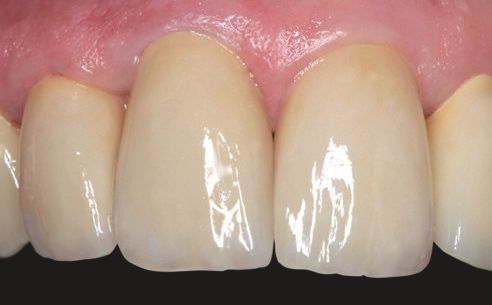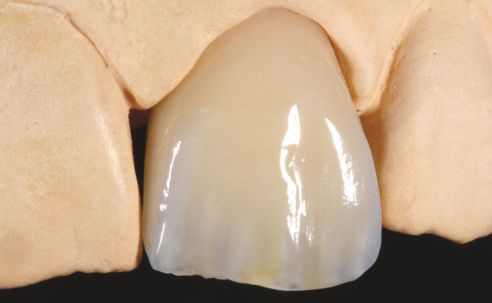Hybrid ceramics in the laboratory: Esthetic results with VITA VM LC flow veneering
With the low-viscous VITA VM LC flow veneering composite and the hybrid ceramic VITA ENAMIC, highly esthetic results can be achieved. The positive processing properties of the new veneering composite, such as the excellent fluidity combined with good stability, have especially convinced master dental technician Jürgen Freitag. In the following article, he describes the technical processing steps and provides tips for use in everyday laboratory work.
1. New restoration in the anterior tooth region
A 39-year-old patient required a new restoration of the anterior teeth 12, 11 and 21 as a result of an accident, since the existing metal ceramic crowns were fractured. The patient wanted a solution that was as economical as possible but also esthetically attractive. It was determined to fabricate three crown frameworks of VITA ENAMIC in the dental practice and to veneer these individually in the dental laboratory.
2. Fabrication and conditioning
After the computer-supported design and fabrication of the crown framework, they were prepared for veneering with VITA VM LC veneering composite. Then they were etched and thoroughly cleaned, then silanized with VITASIL. Finally, VITA VM LC MODELLING LIQUID was applied. After a short dwell time, application of the flow materials was begun. Figures A through E show the technical processing steps in the laboratory using an anterior crown as an example.
3. Processing hints and experiences
For incisal, bluish-translucent effects, our own experience shows that the enamel-effect material EE9 is very well suited. This can be precisely modeled due to the high stability of the flow material - even the finest points are retained. After a short period of light-curing, the effect material EE1 and the clear glass WINDOW material (WIN) are applied. For shape correction, the neutral translucent material (NT) is used. To prevent the development of an oxygen inhibition layer and to simplify molding, the application of a thin layer of VITA VM LC gel is recommended after a short period of light curing and before final polymerization.
4. Finalization and integration
The crowns in this clinical case, which were veneered according to the technical processing steps described, were completed after cleaning under running water (Fig. 1) and technically polished with the VITA ENAMIC Polishing Set (Fig. 2). Following adhesive integration, the restorations could not be visually differentiated from the metal-ceramic crowns (Fig. 3). Figure 4 shows a black-and-white image for the checking of the lightness values. Note the harmonic transition to the gingiva which appears completely free of irritation and contributes to the overall aesthetic impression (Fig. 5).
Report 09/15








